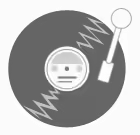| Comments |
Components Corporation, Denville, New Jersey
Label edge is 33 1/3 RPM Stroboscope
Cut by HYDROFEED (R)
Bands A1-5 all end with locked grooves. There is an additional single locked groove prior to the start of band A6, which then features 9 segmented sub-bands.
Band B4 has 3 separately segmented sub-bands and band B5 has 8.
INSTRUCTIONS (Rear cover)
SIDE A - Stereophonic (play only with a stereo cartridge)
BAND 1. Channel Identification Test.
Each channel is identified by voice. The right channel test tone should come from the right speaker; the left channel tone from the left speaker. If the channels are reversed; reverse the speaker leads. Speakers must match the channel tones so sounds recorded on the right will come from the right, and vice-versa. Note: Some stereo amplifiers have a built-in switch for reversing channels.
BAND 2. Metronome Balance Test.
When the sound of the metronome seems to come from a point midway between the two stereo speakers, their relative volume levels are properly balanced. If the sound seems closer to one speaker, the left, for example - decrease the volume of the left or increase in on the right to bring sound to the center.
BAND 3. Speaker Phasing Check.
There are two successive low-pitched tones in the test. If the speakers are properly phased, the first tone will be louder. If the speakers are out of phase, the second tone will be louder. To correct the phasing, reverse the leads on either of the two stereo speakers. For best results listen to this test at a point equidistant from the two speakers. Improper phasing makes stereo sound confusing and unnatural.
BAND 4. & 5. Channel Separation Tests.
The sound meant for one channel should not be heard in the other. When you play band 4, a glide tone for the right channel, listen to the left channel. You should hear little or no sound in the left channel. Band 5 is a glide tone on the left channel and should not be heard through the right channel. You can use an a.c. voltmeter across the appropriate voice coil leads for visual measurement of the separation between the two channels. Set controls for the RIAA curve.
BAND 6. Sound Effects quizz (sic)
This series of special stereo sound effects will dramatically demonstrate the illusion of movement and spaciousness in sound which is possible with stereo. See if your friends can identify the sounds. Here they are in the order you will hear them: (1) Thunderstorm with rain, (2) Farm Tractor, (3) Subway, (4) S.S. Queen Mary, (5) Auction Market, (6) Jet Aircraft, (7) Depth Charge, (8) Bow and Arrow Shots, (9) Chopping down tree.
SIDE B Monophonic. (can be played with either monophonic of stereo equipment)
BAND 1. Stylus Wear Test.
Play the first band and the last one (Band 7) alternately. If the stylus is clean and properly shaped, both bands should equally loud and clear. If the inner band (7) sound rough and raspy, the stylus may be worn or dirty; or the stylus tracking angle may be wrong. Insufficient stylus force (pressure) or a defective cartridge may also cause a raspy tone.
BAND 2. Supersonic glide Band.
This band is recorded at a constant velocity from 35,000 cycles to 1,000 cycles per second. You'll hear a "beep" tone at 5,000 cycle intervals for identification. Few people will hear frequencies above 15,000 cycles per second (the 5th marker "beep"), but if any spurious sound such as buzzes, rattles or whistles are audible, your pickup cartridge may need cleaning and adjustment. Or it may be that damping for tone arm resonance is not effective at these higher frequencies. As the tone glides into the audible range, the sound should be smooth and mellow. A rough, raspy sound may be caused by the cartridge or arm as mentioned above, or (at high volume settings) by the loudspeaker. Loose objects in the room may also vibrate to produce "sympathetic" tones at certain frequencies. In playing this band, set the controls "flat", without the RIAA high-frequencies de-emphasis.
BAND 3. RIAA Equalization Test
Use this band to check RIAA equalization. Set the bass and treble controls and neutral (neither boost nor loss). Because your location while listening for relative smoothness of response, and the acoustics of the room affect the apparent loudness when judging by ear, it is best to use an a.c. voltmeter across the speaker voice coil leads. All frequencies should give the same reading as the 1,000 cycle reference tone.
BAND 4. Check For Rumble.
This band is divided into three sections. The first section has a low pitched tone (30 cps) recorded 20 decibels (db) down from normal maximum recording level (7 cm/s @ 1,000 cps). The second section is recorded 30 decibels down. The third is 40 db down. Use of these reference tones is fully described under band 6.
BAND 5. Tracking test.
Use this band to determine whether or not your tone arm develops audible fundamental resonance (undamped, extraneous "sympathetic" vibration of the arm). There is a slow tone sweep (or glide) from 100 cps down to 5 cps with spaced groves at 80, 60, 40, 30, 20, 15, 10, and 5 cps. If your pickup and tone arm combination has a fundamental resonance below the lowest musical tones on records (usually 20 to 30 cps) then you have no problem unless this resonance happens to fall on a submultiple of a rumble frequency from the turntable. Proper damping will minimize any trouble from such a combination of factors by reducing the severity of the resonance. If the fundamental occurs within the musical range, it will create disconcerting sounds. If damping is not efficient, the arm may vibrate and possible jump out of the groove, especially when playing loud pedal notes from a pipe organ. Undamped vibration can ruin the record after a few playings. This band is also useful for checking smoothness of overall response including the loudspeaker and baffle arrangement. If some frequencies cause audible speaker cabinet vibration, is can be located by feeling various parts of the speaker enclosure with the fingers.
BAND 6. Test for Hum and Rumble
These are quiet grooves, recorded without and signal at all. Turn the volume up until some noise is audible. Turn the treble controls down to minimize surface noise resulting from dust and scratches. Now, move the pickup stylus to the last of the three sections of band 4 - which is 40 decibels down. If the noise on band 6 is less than that of of the last of three sections, the signal to noise ratio is down more than 40 db below standard reference level. This is adequate for most commercial turntables. But, if the third section can't be heard at the level set for 6, try the sections that are 30 and then 20 db down. This would indicate that your set has too much rumble or hum. The quiet grooves have been recorded by the HYDROFEED Master Recording Lathe. This special machine uses the smooth flow of hydraulic force instead of mechanical gears or screw threads to push the cutter across the recording surface.
|




 MyRecordList is free to use - we don't want useless advertising taking up space and the only annoying message you will see on this site is this note asking you to kindly donate whatever you can afford if you use the site regularly or would just like to support a small independent project created for the love of music and record collections.
MyRecordList is free to use - we don't want useless advertising taking up space and the only annoying message you will see on this site is this note asking you to kindly donate whatever you can afford if you use the site regularly or would just like to support a small independent project created for the love of music and record collections.